Dog food keeps changing — maybe you’ve noticed that dog food labels now include all sorts of grains. Or that some companies offer grain-free diets.
Either way, you’re probably wondering whether your dog should eat grains at all. If yes, are whole grains really better than grain-free foods?
Unless your dog has very specific dietary needs or allergies, grains can be a great addition.
But not all grains are the same.
Let’s look at which ones are the best for your furry friend, and which grains should be kept at a minimum.
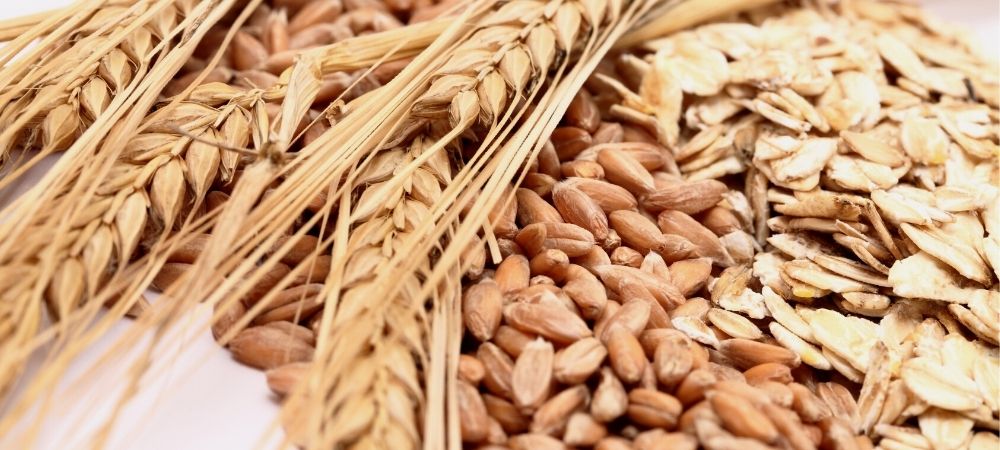
Different Types of Grains
Grains are basically the seeds of grasses.
Not every grain is the same. They can be categorized in several ways.
Glutenous and Gluten-Free Grains
Gluten is a type of protein.
Some grains contain gluten. The typical examples are wheat, barley, rye, and spelt.
But did you know that not all grains have gluten? Corn, rice, and oats are gluten-free.
Gluten–free grains can be an excellent choice for dogs with gluten allergies. Just make sure it says so clearly on the dog food label because sometimes leftovers from other production lines can seep in.
Refined and Whole Grains
Depending on the level of processing, there are:
- Whole grains
- Refined grains
Whole grains have not been processed, so the bran (outer shell) and germ (the embryo and nutrient-rich part of the seed that sprouts into a new plant) are still intact.
Refined grains have been stripped of these two components, leaving mostly endosperm (the starchy food source for baby plants).
Processing removes many nutrients, so you should go for whole grains whenever possible.
Ancient Grains
Finally, not all grains are selected and bred to thrive in industrial agriculture. This is what ancient grains are all about.
All grains are “ancient” in that they’ve been cultivated for thousands of years.
However, grains like amaranth, millet, kamut, and sorghum haven’t been bred for mass production in an industrial setting. They’ve been left to grow wild and untouched, just like how they began in nature.
These grains are naturally tough and can survive harsh conditions. They also have a rich fiber, vitamin, and mineral content.
If you’re looking for grains that are not genetically modified (GMO), go with these ancient grains.
10 Best Grains for Dogs
We’ve already concluded that there are many different grains out there, but what are the best grains for dogs?
There is a general agreement that whole grains and ancient grains are the healthiest and most nutritious. Dog food with these grains provides more fiber, protein, essential fatty acids, and other nutrients.
Take a look at the following options you might find on dog food labels — and pick the ones most suitable for your furry best friend.
Barley

Barley is a well-known grain commonly used for bread and beverage production.
This whole grain is a popular alternative to wheat and corn when it comes to dog food.
It’s usually listed as either barley groats or pearled barley.
Barley groats are actually hulled barley. They are more nutrient-dense since there’s almost no processing involved. Only the outer shell is removed, so most vitamins, minerals, and fiber remain intact.
Pearled barley doesn’t have a hull or bran. This option is lower in nutrients but will still provide energy and some dietary fiber.
Barley is excellent for the heart. It is rich in fiber, potassium, folate, iron, and B6, which support the cardiovascular system. If your dog likes to run around and has high energy, barley will provide the fuel.
Additionally, selenium and beta-glucans fight inflammation, prevent cancer and contribute to weight loss.
Barley is also great for bone health since it contains phosphorus, calcium, copper, zinc, and magnesium. These are all essential minerals for strong bones and healthy joints.
Malted barley is an up-and-coming whole grain. This variant is the most nutritious form of barley, and we are likely to see more of it in future dog foods.
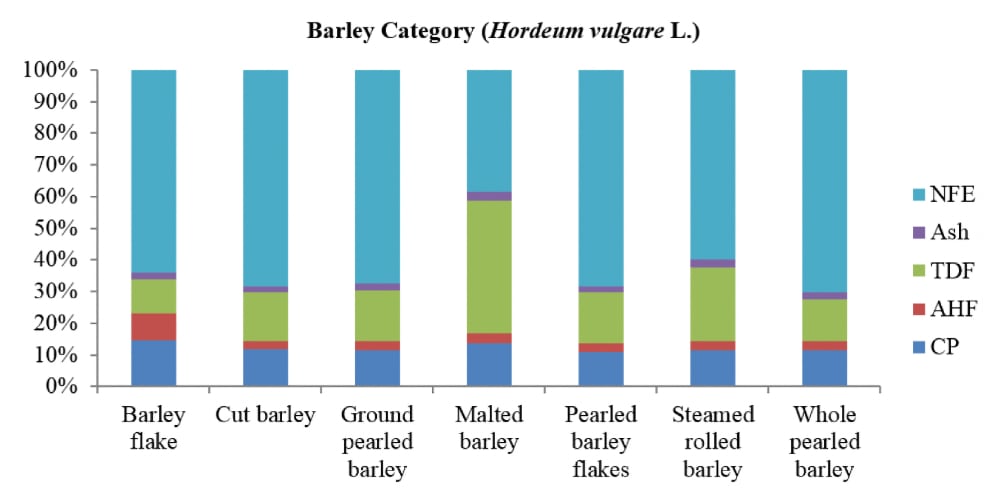
To sum up, barley brings many health benefits to the table: reduced risk of obesity, lower diabetes incidence, and heart disease prevention.
However, barley contains gluten, so it’s not suitable for dogs with a gluten allergy.
Brown Rice
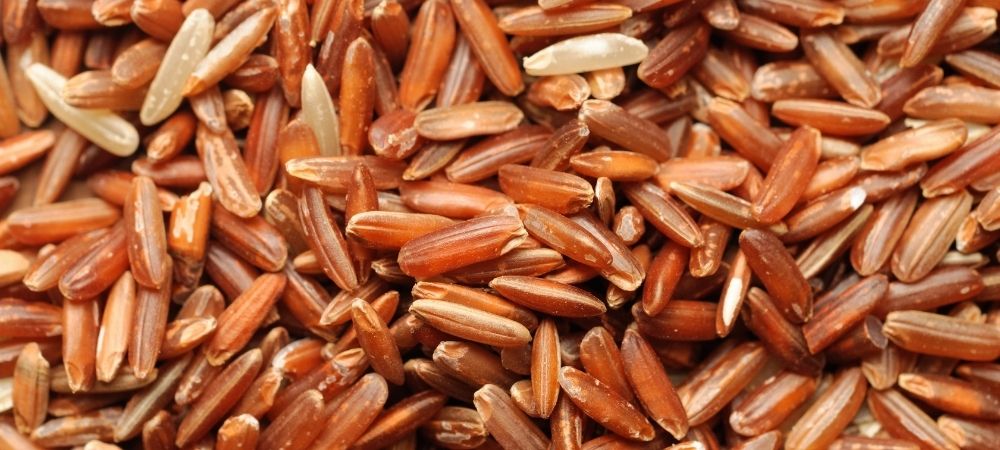
Brown rice is the less refined cousin of white rice. It is a gluten-free, starchy, high-carb whole-grain.
With no fat or sugar and loads of fiber, protein, carbs, vitamins, and minerals — it’s no wonder that brown rice is often seen in premium dog foods.
This grain contains manganese, niacin, thiamine, selenium, and magnesium. Why are they important? These minerals support the nervous system, DNA function, and regulate blood pressure. They are also antioxidants.
In other words, brown rice packs quite a punch of health benefits for your pooch.
It is especially good for dogs with upset stomachs and digestive issues. Brown rice is a good dietary source of fiber, particularly soluble ones. This type of fiber reduces inflammation and prevents colon cancer, along with aiding weight loss.
The list of benefits doesn’t end there.
The whole brown rice also contains lignans and ferulic acid. These compounds are great for your dog’s heart, and they are anti-inflammatory and antimicrobial.
However, like most grains, brown rice contains phytic acid, which is an antinutrient.
The antinutrients have drawbacks. In the case of phytic acid, the body cannot fully absorb zinc. This means that if your dog has low zinc levels, you should be careful with feeding them too much brown rice.
Oat
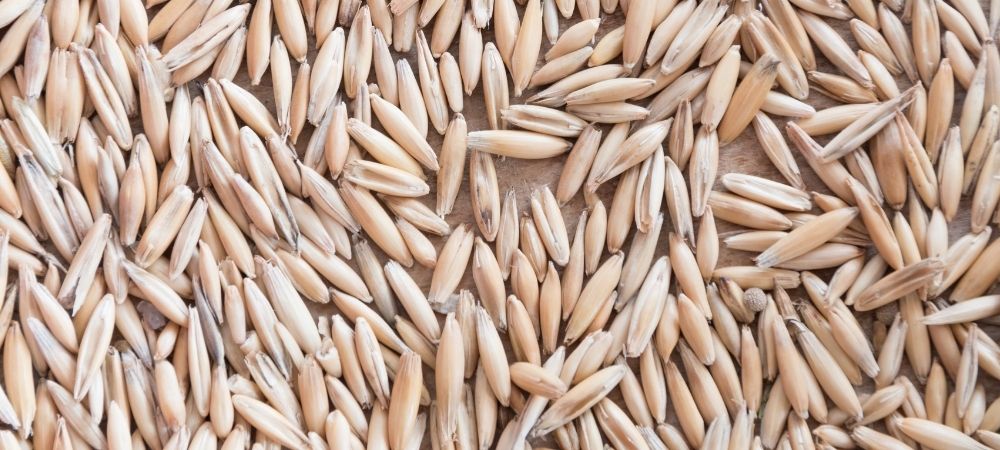
Did you think that oats were just a breakfast cereal? As it turns out, they can be a great addition to your dog’s food as well.
Oat is a whole grain cereal high in vitamins, minerals, antioxidants, and fiber.
The fiber content in oats is especially important because it is made up mostly of beta-glucans and soluble fiber. They are great for digestion.
Oats contain more soluble fiber than any other grain. This means they are great for weight management, slower digestion, and heart health.
Beta-glucans are also highly beneficial as they lower blood sugar and cholesterol.
The heart is made even healthier by avenanthramides, which are compounds found only in oats. They are responsible for cardiovascular health and heart disease prevention.
Oats also contain a lot of dry protein — 11–17%, to be exact. This is more than most other grains, except maybe quinoa. The oat proteins may not all be digestible, but they aren’t harmful.
Because of its specific fiber structure, oat fiber is increasingly used in pet food, and it’s showing a lot of promising benefits for future production.

Premium dog foods typically use ground whole oats.
Rye
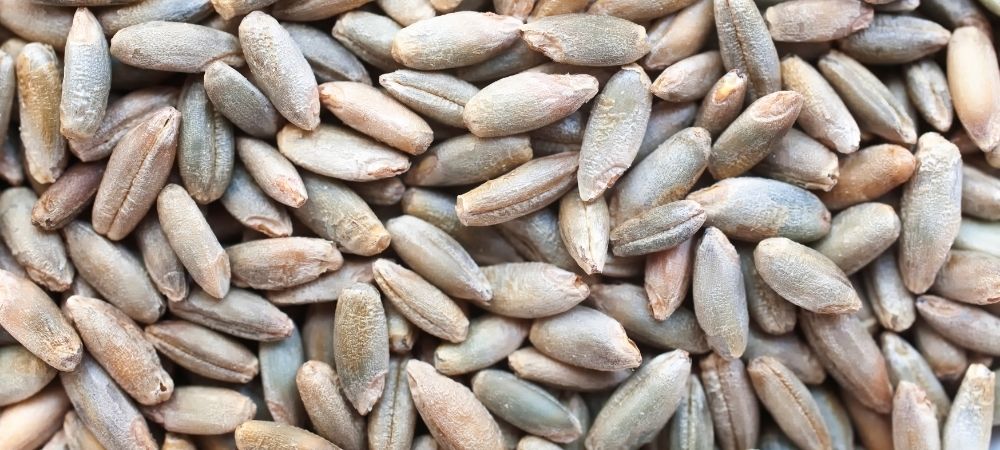
Similar to oats, rye is also often used in weight management formulas.
This is because rye is rich in fiber. High-quality fiber prevents constipation, improves digestion, and helps with weight loss.
Furthermore, this type of fiber is rich in beta-glucans which lower cholesterol. Though young dogs may not have cholesterol problems, some senior dogs develop them.
Rye also contains polyphenols which are antioxidants. These compounds fight inflammation, improve immune response, and ward off infections.
However, bear in mind that rye contains gluten. If your dog is allergic to gluten, it could trigger an allergic reaction.
Whole Wheat
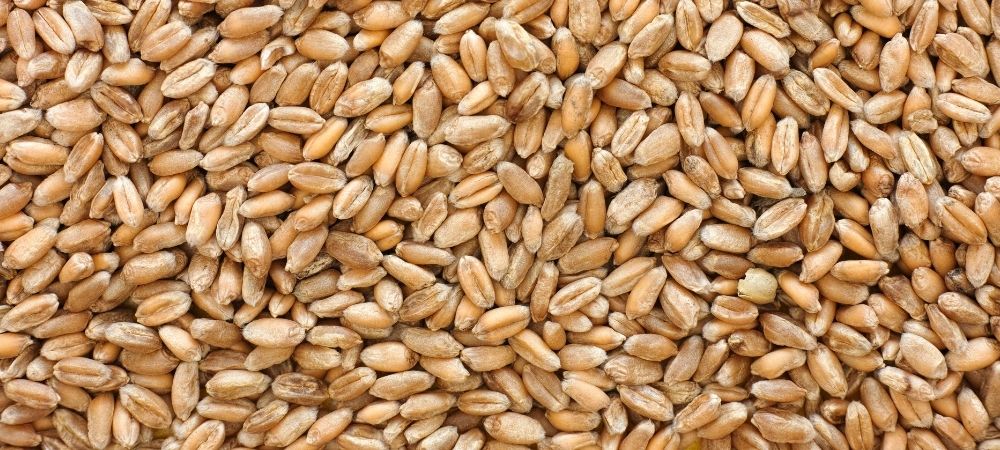
Many people think that wheat is nothing but a cheap filler in dog foods. Nothing could be farther from the truth. High-quality whole wheat is a wonderful source of nutrients.
To start, whole wheat is high in both digestive carbs and dietary fiber. This means it provides a steady, stable source of energy while ensuring the digestive health of your canine companion.
Whole wheat is also high in selenium, manganese, phosphorus, copper, and folate. These minerals, along with other vitamins and antioxidants, support the overall health, immune response, strong bones, ease anxiety, and contribute to many other bodily systems.
Whole wheat is by far the best option because it is unrefined, so most of its nutrients remain within the plant.
It does, however, still contain gluten, so be careful if your dog is sensitive to it.
Millet

Millet is an ancient grain high in fiber, protein, and antioxidants. It is very resistant to pests and mainly used for bird feed.
But why would we feed millet to dogs? As it turns out, this grain contains more essential amino acids than any other. And this means that it is a well-rounded protein source.
It is also very rich in calcium. Finger millet contains more calcium than all other cereal grains. Calcium is vital for bone health, healthy blood vessels, strong muscles, and proper nerve function.
Millet has loads of antioxidants that control blood sugar and lower cholesterol.
This ancient grain is also gluten-free, so it is safe for dogs with gluten allergy and celiac disease. In fact, they can help a lot with these conditions.
Quinoa
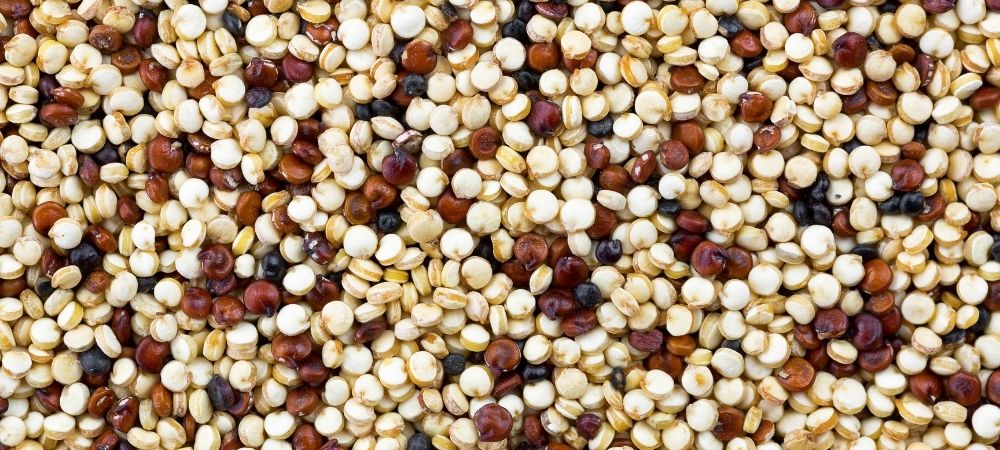
Who hasn’t heard that quinoa is the queen of grains? This pseudo-grain is gluten-free, whole grain, and has more protein than barley, rice, or corn.
These comprise a great nutritional value — and a balanced diet.
Quinoa is very high in lysine, an essential amino acid generally lacking in plants. This makes quinoa one of the rare grains with a complete amino acid profile.
It also has magnesium, iron, fiber, and zinc — much more than other grains.
Then there are vitamins, minerals, and antioxidants. It’s interesting that quinoa also has quercetin — a polyphenol and an antioxidant — that kills cancer cells, prevents heart disease, and lowers blood sugar.
Ready to hand over that crown yet?
Quinoa is suitable for active dogs, dogs with a gluten allergy, and dogs needing that extra immune boost.
Still, bear in mind that quinoa, like many grains, has antinutrients as well.
One of them is phytic acid, which prevents zinc absorption.
However, quinoa is also high in oxalates, which bind calcium. If your dog has kidney problems, quinoa might not be the best food choice, even with all the other remarkable health benefits.
Sorghum
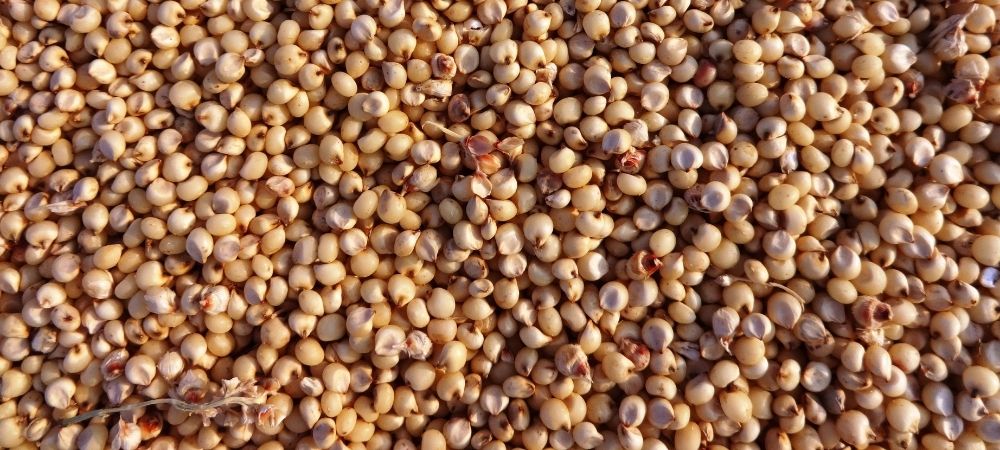
Sorghum is an ancient grain, like millet. It is high in fiber, protein, and B vitamins.
This means that it is very digestible and can boost the immune system.
Sorghum is also rich in antioxidants, which help fight against cancer and heart diseases.
This grain also has calcium, phosphorus, potassium, zinc, manganese, magnesium, iron — which help with digestion and metabolism to keep weight under control.
Additionally, the antioxidants present in sorghum protect your dog from any possible free radical damage.
This grain is suitable for dogs allergic to gluten and may be a good choice for diabetic dogs.
Amaranth

The use of amaranth goes back to the Incas, Mayas, and Aztecs. Leaves and seeds of the plant provided energy and preserved the health of these warriors.
Amaranth is considered a pseudo-grain. It’s not the same species as wheat, barley, or oats. But it shares nutritional characteristics with them and can be used in a similar way.
This superfood has loads of calcium, iron, and zinc, which are the most important minerals for overall body function. It’s also rich in vitamin E and B-vitamins, crucial for mental calm and energy levels.
The plant also supplies plenty of dietary fiber and protein — but without excess carbohydrates. Meaning, your dog’s muscles and digestive system will benefit without the risk of them getting overweight.
The best of all? Amaranth is gluten-free, so it’s safe for dogs with wheat and gluten allergies.
Corn

We saw that it is not true that all grain-inclusive dog food is bad.
However, corn is one of the most controversial products because there are conflicting opinions about its benefits and risks. Lots of pet food manufacturers use corn.
Corn contains antioxidants like lutein, zeaxanthin, and folate (vitamin B9). These antioxidants are crucial for your dog’s eyesight and overall health.
Corn also has phytates that block iron absorption, but it is moderate in proteins and fiber.
Of all the grains, corn contains the least amount of vitamins and minerals. Unfortunately, this means that other ingredients must be added to balance out this deficiency.
However, this is not always a bad thing. It makes corn one of the cheapest ingredients that provide solid dog nutrition.
Still, this does not make corn a magical product.
It has been linked to allergies and digestive issues in some dogs.
In short, there are benefits but also risks when it comes to feeding your dog with corn. When you’re looking at a dog food label — if there is corn, make sure there are other whole grains as well.
Which Grains to Avoid in Dog Food?
The healthy whole grains we mentioned above are a welcome addition to dog foods. You want to limit some traditional grains’ byproducts, though.
Bear in mind that these should not be excluded completely — they still have their place and can complete the nutritional profile of whole grains. But, ideally, they should be a bit lower on the ingredient list.
Wheat Gluten
Wheat gluten is a byproduct of wheat flour production.
As its name suggests, it is rich in gluten, which is a protein. It doesn’t have much starch, even though its texture resembles flour.
Wheat gluten is bad for dogs with wheat and gluten allergy. Feeding your dog this byproduct might result in an allergic reaction.
Corn Gluten Meal
Ironically, corn gluten meal does not contain gluten.
Corn gluten meal (CGM) is a byproduct of the corn milling process. It adds proteins to the dog food.
Although it can raise the overall protein, this is still a plant protein. Plant proteins are less digestible than animal ones.
Furthermore, CGM is much lower in nutrients than the actual corn. So it’s mostly used as a filler.
Wheat Middlings
Wheat middling is often used in cattle feed. It is a byproduct of the wheat milling process, consisting of the bran, shorts, germ, flour, and other production particles.
Wheat middlings is actually rich in protein, fiber and even has B vitamins. However, it is not as nutritious as whole wheat.
Cereal Fines
Cereal fines are the leftover particles of cereal processing.
The main problem with cereal fines is that they are often unnamed in the ingredient list.
While it may contain various nutrients, we often can’t be sure of its nutritional value or potential allergies it might trigger.
Grain Hulls
Grain hulls are sometimes added to dog food in order to provide fiber.
However, the hulls themselves are not as nutritious as the whole grain.
Though these hulls mostly come from rice or oat, there are also other sources. If they are unnamed, it’s hard to determine their nutritional value and potential risks.
Should Your Dog Go Grain-Free?
There has been a lot of talk about a grain-free diet for dogs.
The rationale is that grain-free diets don’t have ingredients that might trigger or aggravate gluten or wheat allergies.
However, for most dogs, gluten and wheat allergies are not that common. In fact, animal protein allergies come first. The most common ones are beef and fresh chicken.
In 2019, the FDA started an investigation into the grain-free diet because they suspected it contributed to dogs’ dilated cardiomyopathy (DCM). DCM is a severe heart disease that can be fatal.
Before choosing any type of regime for your dog, whether it’s a grain-inclusive diet or a grain-free food, it’s best to ask for veterinary advice.
Our Verdict
Healthy grains can be a wonderful addition to a dog’s diet if you know which ones suit your dog’s dietary needs.
Check if your dog has any food sensitivities and choose accordingly.
Luckily, many pet food manufacturers offer a wide array of high-quality grains. It shouldn’t be too hard for dog owners to pick the best ones.
If you’re still unsure, it’s always best to consult a vet — they will provide a much clearer picture of how to choose the best dog food for our furry friends.

